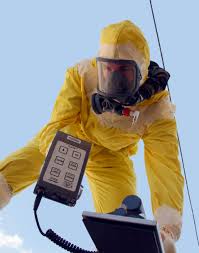Radiation Safety Program Requirements: A Quick Refresher for X-ray Techs

There are certain radiation safety program requirements for healthcare facilities. Staying up-to-date on radiation safety measures is important for X-ray techs. It can help identify potential problems before they lead to a major accident.
Types of Radiation Safety Controls at Healthcare Facilities
Radiation safety controls are methods of ensuring a safe working environment for radiation equipment operators. Every healthcare facility must comply with certain radiation safety program requirements. There are primarily two types of safety controls in medical radiation facilities- engineered and administrative.
Engineered Controls
Engineered controls are fixed shielding materials that help avoid unnecessary radiation exposure. For example, lead-lined walls and lead shielding are examples of engineered radiation safety controls. Lead shielding and walls are made of high-density lead or concrete or a combination of the two such that they are impermeable to radiation. In addition, another component of the radiation safety program requirements is precautionary warning lights. These indicate a radiation procedure is currently underway.
Sensors help determine the amount of radiation in an area and are another examples of engineered controls. To ensure the protection of workers and patients in any area, it is important to ensure that engineered radiation safety controls are not bypassed or tampered with.
Administrative Controls
Administrative controls are procedures, training, and dosimetry. These are an important component of the radiation safety program requirements. US Federal Law mandates that any person receiving an annual occupational dose limit of more than 10 percent should undergo periodic radiation exposure monitoring.
Medical imaging facilities must enforce a program in order to ensure workers and patients remain sufficiently protected from exposure to ionizing radiation. The administration of every facility must implement these radiation safety program requirements. The management should make necessary resources available, such as equipment and operational funds. It is also the responsibility of the facility’s management to develop and implement policies and procedures with reference to the radiation safety program.
NRC Radiation Safety Program Requirements
The NRC requires every radiation facility to appoint a committee on radiation safety. This committee establishes and oversees the safety program and conducts continuing evaluation and monitoring. These are critical radiation safety program requirements.
A designated radiation safety officer (RSO) is appointed to supervise everyday operations and perform formal annual reviews. Any qualified individual, such as a radiologist or a medical physicist with sufficient training and a background in radiology, can fulfill the role of an RSO. NRC-approved healthcare facilities can choose or designate an appropriate person as the RSO who will ensure that the facility adheres to internationally recognized radiation safety program requirements for radiation protection.
Duties of the RSO
The radiation safety officer maintains exposure records for all staff members for counseling purposes. Once a radiation worker reaches the maximum allowable limit, they are subjected to monitoring and consultation. The RSO also develops and implements radiation safety program requirements at the medical facility. This ensures every individual involved in radiation procedures is well protected. To fulfill their duties, an RSO must have complete authority to execute and enforce a safety program.
RSO Training
Section 10 of the CFR outlines the requirements that radiation safety officers must fulfill in terms of training. These are in accordance with regulatory guidelines published by the NRC. They are essential radiation safety program requirements. An RSO must comply with one of three training pathways:
- Certification from at least one NRC-approved professional board.
- Sufficient work experience as described in the regulations.
- Authorized medical physicist or licensed nuclear physicist with adequate experience in work similar to the responsibilities of an RSO.
Section 10 CFR 35.24 says that the licensing and governing body must give the RSO adequate authority, management prerogative, and organizational freedom in order to execute the following roles:
- Identify problems related to radiation safety.
- Recommend and initiate necessary corrective actions.
- Discontinue any unsafe operations that produce hazardous by-products.
- Validate the implemented corrective actions.
Authority of the RSO
The duties, responsibilities, and authority of the radiation safety officer should be appropriately publicized to create awareness amongst all radiation workers. The RSO oversees compliance with radiation safety program requirements on a daily basis. Besides, he or she ensures unsafe operational procedures are discontinued. The RSO also ensures that radioactive materials are safely utilized. The RSO’s duties are to maintain a safe environment for patients and workers. To fulfill this role, they need certain resources from the facility’s management.
The RSO is additionally responsible for rotational scheduling of radiation staff members. This ensures that risk of exposure does not get concentrated on one team or one individual. This is an important feature among the various radiation safety program requirements. For instance, if a facility routinely conducts more exams during the day shift, the workers on daytime duty have a higher exposure. The RSO should in such a case consider alternating night and day shifts every other month to even out the exposure amongst all personnel. However, personnel tend to become accustomed to a routine and changes in the shift schedule are not always welcome. In general, is easier to shift staff from high-risk to low-risk procedures.
DXA Continuing Education
We offer several online courses for radiologic technologists. These are good for the required CEUs to complete ARRT® requirements for recertification. For example, our course ALARA in Digital Radiography, is worth 4 CEUs, and will allow you to update yourself on reducing patient radiation exposure. DXA operators may consider purchasing our bone densitometry e-course which is worth 23 CE credits. You have the flexibility to choose the type and number of credits you need. Visit our online shop today.
Here is more about xray continuing education courses.
